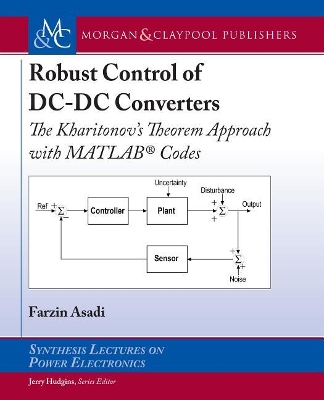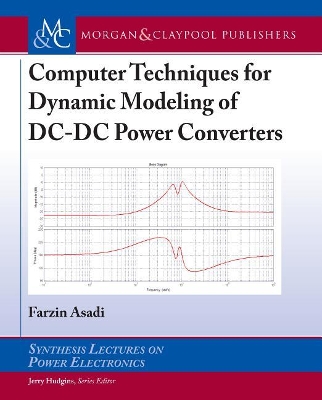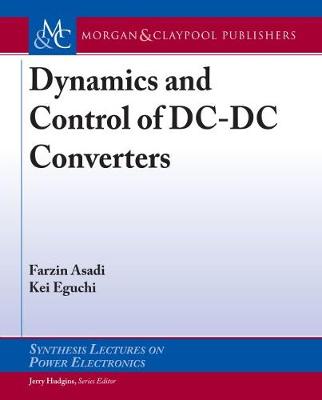Synthesis Lectures on Power Electronics
3 total works
DC-DC converters require negative feedback to provide a suitable output voltage or current for the load. Obtaining a stable output voltage or current in the presence of disturbances like input voltage changes and/or output load changes seems impossible without some form of control.
This book shows how simple controllers such as Proportional-Integral (PI) can turn into a robust controller by correct selection of its parameters. Kharitonov's theorem is an important tool toward this end.
This book consist of two parts. The first part shows how one can obtain the interval plant model of a DC-DC converter. The second part introduces the Kharitonov's theorem. Kharitonov's theorem is an analysis tool rather than a design tool. Some case studies show how it can be used as a design tool.
The prerequisite for reading this book is a first course on feedback control theory and power electronics.
This book shows how simple controllers such as Proportional-Integral (PI) can turn into a robust controller by correct selection of its parameters. Kharitonov's theorem is an important tool toward this end.
This book consist of two parts. The first part shows how one can obtain the interval plant model of a DC-DC converter. The second part introduces the Kharitonov's theorem. Kharitonov's theorem is an analysis tool rather than a design tool. Some case studies show how it can be used as a design tool.
The prerequisite for reading this book is a first course on feedback control theory and power electronics.
Computer Techniques for Dynamic Modeling of DC-DC Power Converters
by Farzin Asadi
Published 28 August 2018
Computers play an important role in the analyzing and designing of modern DC-DC power converters. This book shows how the widely used analysis techniques of averaging and linearization can be applied to DC-DC converters with the aid of computers. Obtained dynamical equations may then be used for control design.
The book is composed of two chapters. Chapter 1 focuses on the extraction of control-to-output transfer function. A second-order converter (a buck converter) and a fourth-order converter (a Zeta converter) are studied as illustrative examples in this chapter. Both ready-to-use software packages, such as PLECS (R) and MATLAB (R) programming, are used throught this chapter.
The input/output characteristics of DC-DC converters are the object of considerations in Chapter 2. Calculation of input/output impedance is done with the aid of MATLAB (R) programming in this chapter. The buck, buck-boost, and boost converter are the most popular types of DC-DC converters and used as illustrative examples in this chapter.
This book can be a good reference for researchers involved in DC-DC converters dynamics and control.
The book is composed of two chapters. Chapter 1 focuses on the extraction of control-to-output transfer function. A second-order converter (a buck converter) and a fourth-order converter (a Zeta converter) are studied as illustrative examples in this chapter. Both ready-to-use software packages, such as PLECS (R) and MATLAB (R) programming, are used throught this chapter.
The input/output characteristics of DC-DC converters are the object of considerations in Chapter 2. Calculation of input/output impedance is done with the aid of MATLAB (R) programming in this chapter. The buck, buck-boost, and boost converter are the most popular types of DC-DC converters and used as illustrative examples in this chapter.
This book can be a good reference for researchers involved in DC-DC converters dynamics and control.
DC-DC converters have many applications in the modern world. They provide the required power to the communication backbones, they are used in digital devices like laptops and cell phones, and they have widespread applications in electric cars, to just name a few.
DC-DC converters require negative feedback to provide a suitable output voltage or current for the load. Obtaining a stable output voltage or current in presence of disturbances such as: input voltage changes and/or output load changes seems impossible without some form of control.
This book tries to train the art of controller design for DC-DC converters. Chapter 1 introduces the DC-DC converters briefly. It is assumed that the reader has the basic knowledge of DC-DC converter (i.e., a basic course in power electronics).
The reader learns the disadvantages of open loop control in Chapter 2. Simulation of DC-DC converters with the aid of Simulink® is discussed in this chapter as well. Extracting the dynamic models of DC-DC converters is studied in Chapter 3. We show how MATLAB® and a software named KUCA can be used to do the cumbersome and error-prone process of modeling automatically. Obtaining the transfer functions using PSIM® is studied as well.
These days, softwares are an integral part of engineering sciences. Control engineering is not an exception by any means. Keeping this in mind, we design the controllers using MATLAB® in Chapter 4.
Finally, references are provided at the end of each chapter to suggest more information for an interested reader. The intended audiences for this book are practice engineers and academians.
DC-DC converters require negative feedback to provide a suitable output voltage or current for the load. Obtaining a stable output voltage or current in presence of disturbances such as: input voltage changes and/or output load changes seems impossible without some form of control.
This book tries to train the art of controller design for DC-DC converters. Chapter 1 introduces the DC-DC converters briefly. It is assumed that the reader has the basic knowledge of DC-DC converter (i.e., a basic course in power electronics).
The reader learns the disadvantages of open loop control in Chapter 2. Simulation of DC-DC converters with the aid of Simulink® is discussed in this chapter as well. Extracting the dynamic models of DC-DC converters is studied in Chapter 3. We show how MATLAB® and a software named KUCA can be used to do the cumbersome and error-prone process of modeling automatically. Obtaining the transfer functions using PSIM® is studied as well.
These days, softwares are an integral part of engineering sciences. Control engineering is not an exception by any means. Keeping this in mind, we design the controllers using MATLAB® in Chapter 4.
Finally, references are provided at the end of each chapter to suggest more information for an interested reader. The intended audiences for this book are practice engineers and academians.


